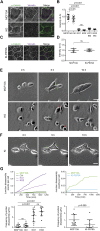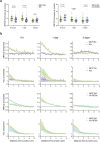Vinculin-Arp2/3 interaction inhibits branched actin assembly to control migration and proliferation
- PMID: 39547716
- PMCID: PMC11568829
- DOI: 10.26508/lsa.202402583
Vinculin-Arp2/3 interaction inhibits branched actin assembly to control migration and proliferation
Abstract
Vinculin is a mechanotransducer that reinforces links between cell adhesions and linear arrays of actin filaments upon myosin-mediated contractility. Both adhesions to the substratum and neighboring cells, however, are initiated within membrane protrusions that originate from Arp2/3-nucleated branched actin networks. Vinculin has been reported to interact with the Arp2/3 complex, but the role of this interaction remains poorly understood. Here, we compared the phenotypes of vinculin knock-out (KO) cells with those of knock-in (KI-P878A) cells, where the point mutation P878A that impairs the Arp2/3 interaction is introduced in the two vinculin alleles of MCF10A mammary epithelial cells. The interaction of vinculin with Arp2/3 inhibits actin polymerization at membrane protrusions and decreases migration persistence of single cells. In cell monolayers, vinculin recruits Arp2/3 and the vinculin-Arp2/3 interaction participates in cell-cell junction plasticity. Through this interaction, vinculin controls the decision to enter a new cell cycle as a function of cell density.
© 2024 James et al.
Conflict of interest statement
The authors declare that they have no conflict of interest.
Figures


















References
-
- Alexandrova AY, Arnold K, Schaub S, Vasiliev JM, Meister J-J, Bershadsky AD, Verkhovsky AB (2008) Comparative dynamics of retrograde actin flow and focal adhesions: Formation of nascent adhesions triggers transition from fast to slow flow. PLoS One 3: e3234. 10.1371/journal.pone.0003234 - DOI - PMC - PubMed
MeSH terms
Substances
LinkOut - more resources
Full Text Sources
Research Materials
Miscellaneous
